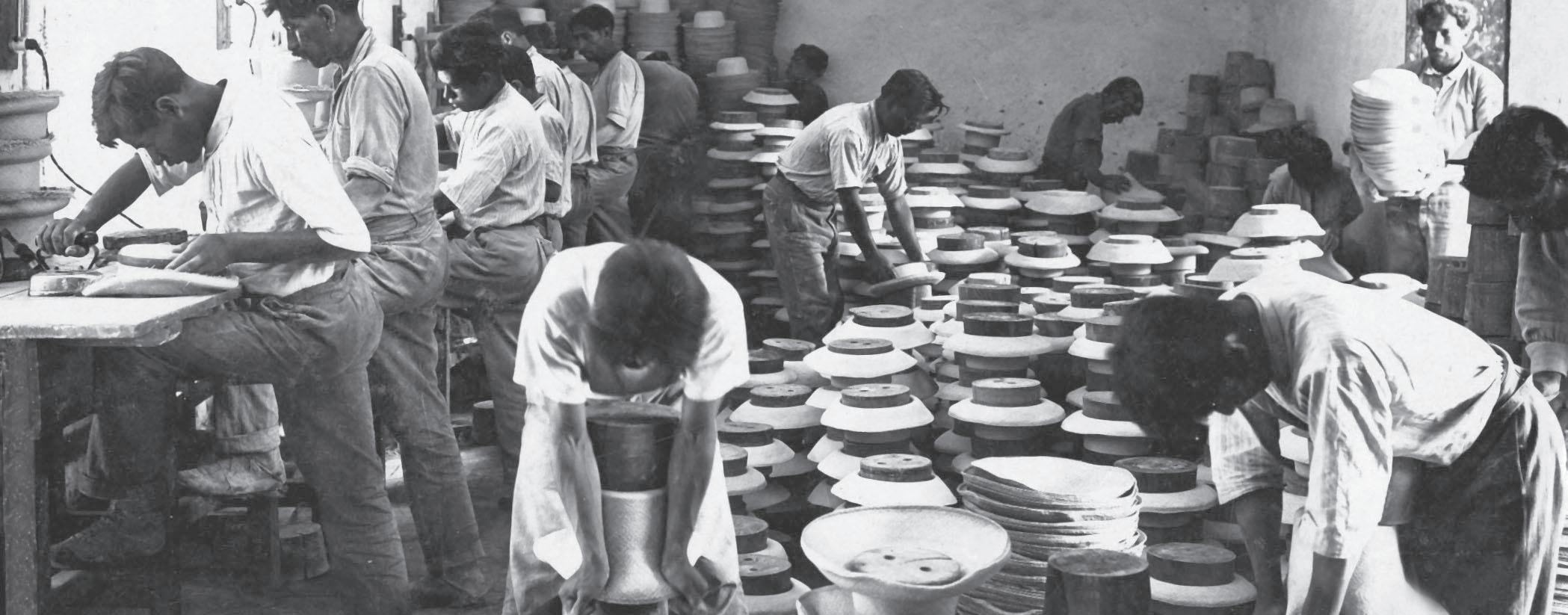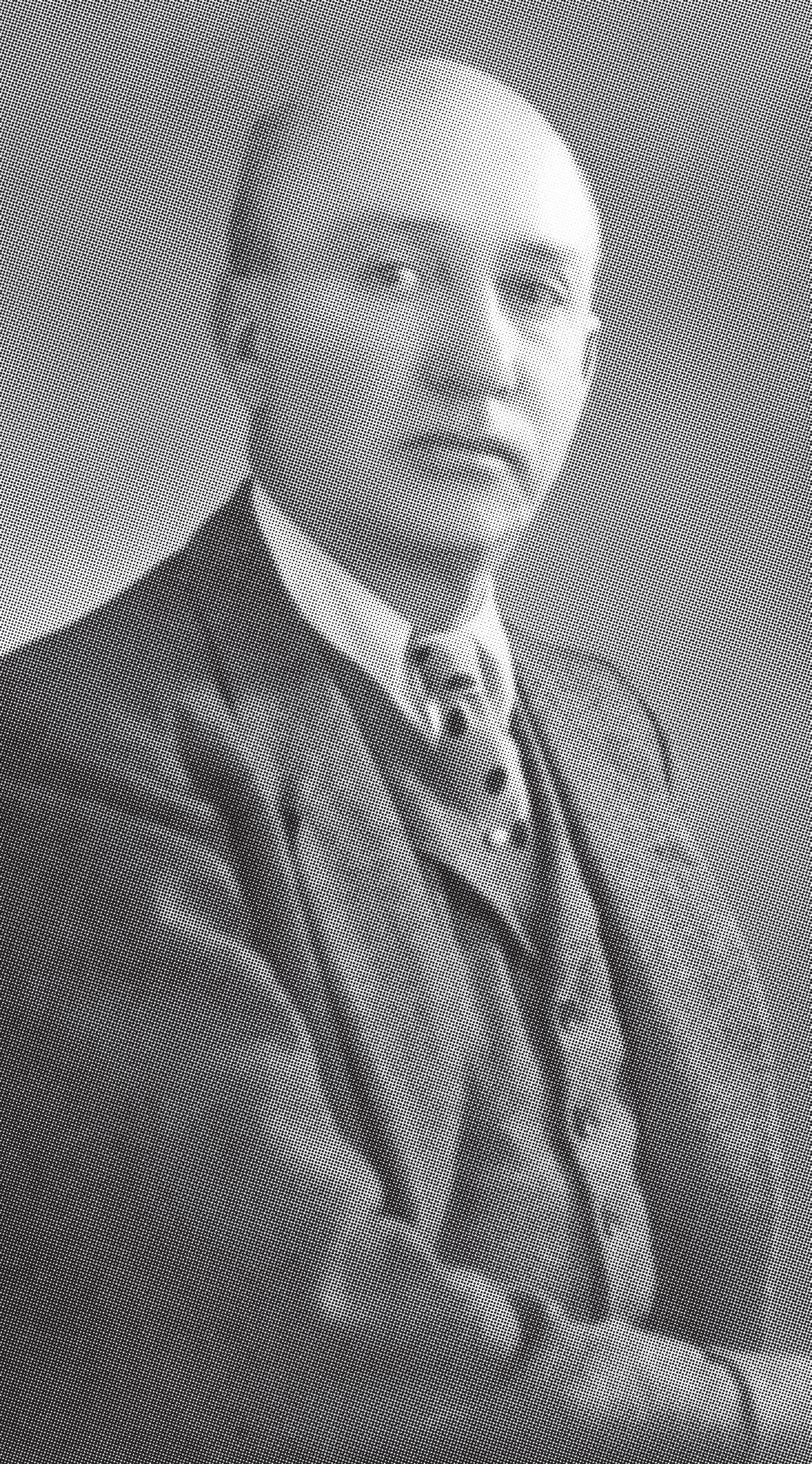
9 minute read
LAS DOS REUNIONES DE LAS CUATRO DE LA TARDE TWO MEETINGS AT FOUR IN THE AFTERNOON
CAPÍTULO // CHAPTER 1
Trabajadores del sombrero de paja toquilla // Laborers of paja toquilla hat
Advertisement
LAS DOS REUNIONES DE LAS CUATRO DE LA TARDE TWO MEETINGS AT FOUR IN THE AFTERNOON
Foto // Photo Felipe Díaz H.
El lunes 7 de septiembre de 1936, el periodista del diario El Mercurio encargado de escribir las noticias económicas se enfrentó a una disyuntiva: los dos eventos de la jornada que debía cubrir estaban programados para las 16h00 en dos lugares diferentes.
El reportero no podía hacerse el distraído o alegar desconocimiento de al menos uno de los eventos.
Su diario había anticipado el domingo 6 que todos los representantes de las casas exportadoras de sombreros de paja toquilla1 se reunirían el lunes en los salones del Hotel Patria para analizar qué remuneración debía ser pagada a los obreros del sector. On Monday September 7, 1936, the journalist in charge of the financial section of the newspaper “El Mercurio” faced a dilemma: the two events he had to cover were scheduled for four in the afternoon--in two different places.
Both events were extremely important so missing either one of them was out of the question.
The day before, on Sunday the 6th, the newspaper had printed the news that representatives of the “paja toquilla”1 hat exporters would be meeting on Monday in the Patria Hotel to discuss wages for the sector.
El viernes 4, el periódico también había publicado el aviso firmado por el presidente de la Cámara de Comercio del Azuay, Manuel Arturo Cisneros Naranjo, que convocaba a los industriales de la ciudad al encuentro del lunes en su local, ubicado en el tercer piso del edificio del Banco del Azuay, “a fin de que se lleve a debido efecto el Decreto Supremo que crea las Cámaras de Industriales”.
Hoy no podemos saber a ciencia cierta si había uno o más periodistas en ese matutino encargados de las noticias de Economía, si tal disyuntiva existió o si hubo una decisión consciente de cubrir uno de los eventos e ignorar el otro, pero leyendo El Mercurio del 8 de septiembre de 1936 sí conocemos cuál de las dos reuniones recibió la atención del diario.
Ese martes, en primera página, se lee el siguiente titular: “Ayer reuniéronse exportadores de sombreros para acordar salarios que deben percibir los obreros que se dedican a la compostura de sombreros de paja toquilla”.
La noticia, que informa sobre la conformación de “sendas comisiones para el mejor entendimiento” (bajo la atenta mirada del señor Francisco Talbot, inspector de Trabajo de Cuenca), aparece debajo de una inmensa publicidad de la aerolínea Panagra, que promocionaba sus tarifas para enviar los sombreros por expreso aéreo desde Guayaquil.
(Dentro del continente americano, el flete básico era de medio kilo, mientras que para los vuelos transoceánicos, era de una libra, y en
(Dentro del continente americano, el flete básico era de medio kilo, mientras que para los vuelos transoceánicos, era de una libra, y en los embarques a los Estados Unidos el flete era “proporcionalmente menor, a medida que aumenta el peso”).
“Nunca hablé de esto con mi padre, pero yo le cuento que era muy importante el sombrero de paja toquilla y todo lo relacionado en el negocio en esos tiempos” recuerda Eduardo Ugalde, quien fue hasta la primera década del siglo actual gerente de la casa On Friday the 4th, the newspaper had also printed an announcement made by the President of the Chamber of Commerce of Azuay, Manuel Arturo Cisneros Naranjo, inviting the industrial leaders of the city to meet on the third floor of the Banco del Azuay “in order to properly execute a Supreme Executive Decree creating the Chambers of Industries.”
Today we have no idea if there was more than one journalist covering the financial news that morning, or if it was a conscientious decision to attend one of the events and ignore the other. What we do know is that on September 8 El Mercurio did give its undivided attention to one of the meetings.
That Tuesday one of the paper’s headlines read: “Hat exporters met yesterday to decide on salaries for laborers of paja toquilla hats.”
The news, which reported on the “high commissions reached for achieving better understanding” (and overseen by Mr. Francisco Talbot, Cuenca’s Labor Inspector), appeared right under a huge Panagra Airline advertisement promoting its fares for hat transportation from Guayaquil.
(On the American Continent the minimum freight charge was for half a kilo. For transoceanic flights it was based on a pound, and the freight for shipments to the United States was “proportionately less as weight increased”).
“I never talked about this with my father, but I can say that at that time the production and export of paja toquilla hats was extremely important as was everything related to the hat business ” remembers Eduardo Ugalde, who managed the Homero Ortega hat export company until the first decade of the this century.
“In those days, if a meeting was to be held in which the salaries of the hat laborers was going to be discussed then, obviously, El Mercurio would give its full attention to an established institution such as the hat business. It was something that, as we say locally, “fills the stomach”2 .
exportadora de sombreros Homero Ortega.
“Entonces, si había una reunión en la que se tenía que tratar sueldos de las personas que trabajaban en sombreros, lo lógico era que El Mercurio tenía que poner toda la atención en algo que estaba establecido. En algo que, como decimos nosotros muy vulgarmente, ‘coge el estómago’”.
Desconocemos si el suegro de Eduardo Ugalde, Homero Ortega, estaba en los salones del Hotel Patria; pero sí sabemos que su padre, Nestorio Ugalde, asistió a la reunión que tuvo lugar a las 16h00 en el Banco del Azuay: Nestorio fue elegido ese 7 de septiembre como el primer tesorero que tuvo la Cámara de Industrias.
It is still unknown if Eduardo Ugalde’s father-in-law, Homero Ortega, was there that day in the meeting at the Patria Hotel. We do know that his father, Nestorio Ugalde, attended the meeting that took place at four o’clock in the Banco del Azuay. That day Nestorio was chosen as the Chamber of Industries first treasurer.

The first president was Guillermo Crespo Ordóñez with Julio Vinueza Acevedo as vice-president. Dr. Alfonso Pozo was chosen as secretary and the other board members were: Carlos Tosi Siri, Cornelio Vintimilla Muñoz, Arturo Cisneros Naranjo, Tomás Rodríguez and Santiago Molinari.
1 Paja toquilla hace referencia tanto a la fibra vegetal utilizada para producir sombreros como al nombre del muy conocido Panama Hat el cual es producido en Cuenca-Ecuador.
1 Paja toquilla is a Spanish reference both to the vegetable fiber used to produce the hats as well as the name of the well Known Panama Hat that is manufactured in Cuenca - Ecuador.
2 This is a common saying that expresses gratifying satisfaction about something. Guillermo Crespo Ordóñez Foto // Photo Felipe Díaz H.
El primer presidente fue Guillermo Crespo Ordóñez, secundado como vicepresidente por Julio Vinueza Acevedo. El doctor Alfonso Pozo fue elegido secretario y las vocalías recayeron en Carlos Tosi Siri, Cornelio Vintimilla Muñoz, Arturo Cisneros Naranjo, Tomás Rodríguez y Santiago Molinari.
La mayoría no tenía vínculos directos con la principal actividad económica de la ciudad, la exportación de sombreros (años después el quiteño Vinueza ingresará a este negocio con el escocés Ernest French), sino que provenían de ámbitos muy diversos como la molienda, el suministro de electricidad, la industria textil, el sector licorero y el negocio de la curtiembre.
No es posible que aquellos primeros industriales supieran que dos décadas después de aquella tarde de septiembre, la marea cambiaría radicalmente de dirección. Nadie podía imaginar que el mundo dejaría de usar sombrero muy pronto.
Tampoco era fácil de preveer que entre las ruinas dejadas por el colapso de la exportación de sombreros, la ciudad miraría hacia la industria como su principal tabla de salvación. Aunque para el historiador Juan Cordero, posiblemente esos hombres sí sabían que estaban haciendo Historia. “Yo sí creo que ha habido en Cuenca un grupo bastante amplio de personas que han pensado por la ciudad y han creído que la aportación es ver el futuro, lo cual es una actitud muy inteligente. Y dentro de esta previsión de futuro creo yo que está el nacimiento primero de la Cámara de Comercio y después de la Cámara de Industrias”. Las noticias de las negociaciones entre exportadores y obreros volverían a las páginas de la prensa local el miércoles 9 de septiembre de 1936, cuando se informa sobre la integración de la mesa directiva del gremio de compositores de sombreros. Y luego el viernes 11, día en el que se habla de una “enorme baja” que sufrió el jueves 10 el mercado de sombreros de paja toquilla Pero entre estas noticias del salario de los obreros compositores de sombreros, la evolución de la Guerra Civil Española, la Most of these men were not directly related to the main economic activity of the city, which was hat exportation. (Some years later Vinueza, originally from Quito, would enter the hat business alongside the Scotsman, Ernest French). Instead, they came from diverse manufacturing sectors such as milling, electrical generation, textiles, liquors and leather tanning.
Those first industrial pioneers could not foresee that two decades later, the tides would change, and the world would stop wearing the paja toquilla hat.
It was also hard to predict that in the midst of the ruins left by the collapse of the hat industry, the city would look toward industry as its main economic activity. But, according to historian Juan Cordero, those men probably did realize that they were making history.
“I believe that in Cuenca there have always been people that have fought for the city’s best interests and have believed that working toward a better future is the best contribution they can make, which happens to be a very intelligent attitude.” Within the scope of this foresight, I think the creation of the Chamber of Commerce
and the Chamber of Industries should also be included.” News about negotiations between exporters and laborers returned to local newspapers when the Board of Directors of the hat-manufacturing sector was named on September 9, 1936. And again on September 11th, when there were reports on the “huge drop” that the paja toquilla hat market had suffered the
day before. Throughout that week in September, there was no other reference as to what had transpired on the third floor of the Banco del Azuay. The news in the paper that week talked about salaries for hat weavers, the Spanish Civil War, the inauguration of the annual National Socialist Convention in Nuremberg, Germany,
headed by Adolf Hitler and the visit of the Archbishop to Quito
inauguración por parte de Adolf Hitler de la Convención anual Nacional-Socialista en Nuremberg y la visita del Nuncio Apostólico a Quito, no aparecerán en toda aquella semana de septiembre más referencias a lo que pasó en el tercer piso de la Cámara de Comercio.
Curiosamente, la única mención a la fundación de la Cámara de Industrias que aparece en El Mercurio esa semana se produce el día posterior a la reunión.
En su ejemplar del 8 de septiembre, el diario vuelve a publicar la invitación a los industriales de la ciudad al evento que tuvo lugar 24 horas antes. Curiously, the only mention made by El Mercurio in reference to the founding of the Chamber of Industries appeared the day after the meeting.
On September 8th, the newspaper once again printed the invitation made to the industrial leaders of the city for the event that had already taken place 24 hours earlier.










